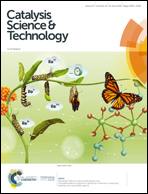Effect of conduction band potential on cocatalyst-free plasmonic H2 evolution over Au loaded on Sr2+-doped CeO2†
Abstract
There is little information on the effect of the conduction band (CB) position on plasmonic hydrogen (H2) formation under visible light irradiation over gold (Au) nanoparticles supported on semiconductors because there were no appropriate materials for which the CB position gradually changes. In this study, we analyzed the flatband potential of strontium ion (Sr2+)-doped cerium(IV) oxide (CeO2:Sr) and found that the CB position gradually shifted negatively from +0.031 V to −1.49 V vs. NHE with an increase in the Sr2+ mole fraction. Plasmonic photocatalysts consisting of Au nanoparticles, CeO2:Sr and a platinum (Pt) cocatalyst were prepared and characterized by using X-ray diffraction, UV-vis spectroscopy, and transmission electron spectroscopy. Photocatalytic reaction under visible light irradiation revealed that H2 was produced over Au nanoparticles supported on CeO2:Sr having the CB potential of −0.61 V vs. NHE and that the negative limit of the CB position for electron injection from Au nanoparticles existed between −0.61 V and −1.49 V vs. NHE. We found that Au/CeO2:Sr plasmonic photocatalysts also produced H2 without the aid of a Pt cocatalyst due to the sufficiently negative potential of electrons injected into the CB of CeO2:Sr.



 Please wait while we load your content...
Please wait while we load your content...
